Diabetes Management and Self-Care
VerifiedAdded on 2020/06/06
|9
|1531
|49
AI Summary
This assignment delves into the management of type 2 diabetes. It explains how HbA1c levels are used to diagnose diabetes, highlighting the normal range and diagnostic thresholds. The document emphasizes self-monitoring of blood glucose using meters and storing results. It also discusses various insulin administration methods like injections and pumps for individuals with type 1 diabetes. Finally, it touches upon the importance of understanding diabetes, its causes, and management techniques.
Contribute Materials
Your contribution can guide someone’s learning journey. Share your
documents today.
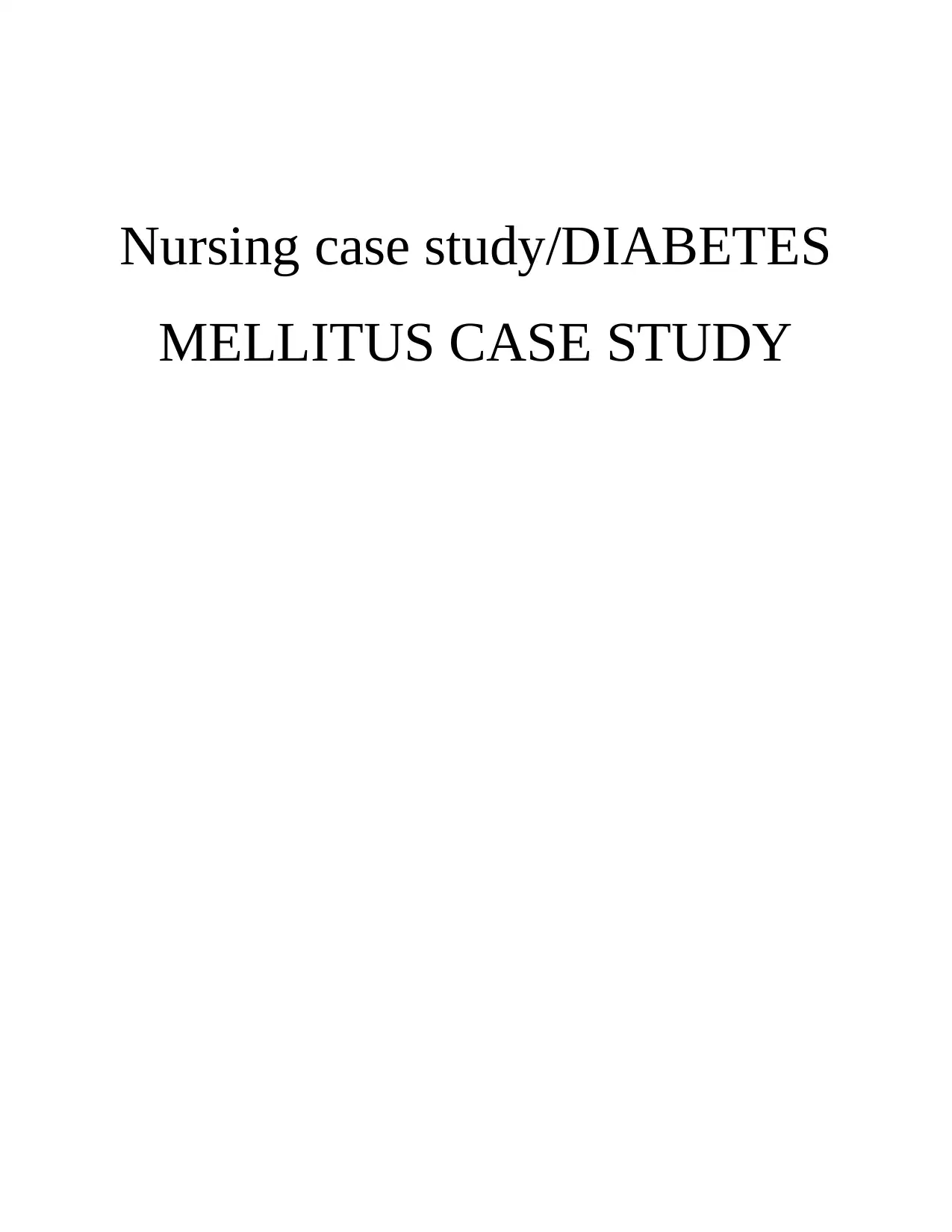
Nursing case study/DIABETES
MELLITUS CASE STUDY
MELLITUS CASE STUDY
Secure Best Marks with AI Grader
Need help grading? Try our AI Grader for instant feedback on your assignments.
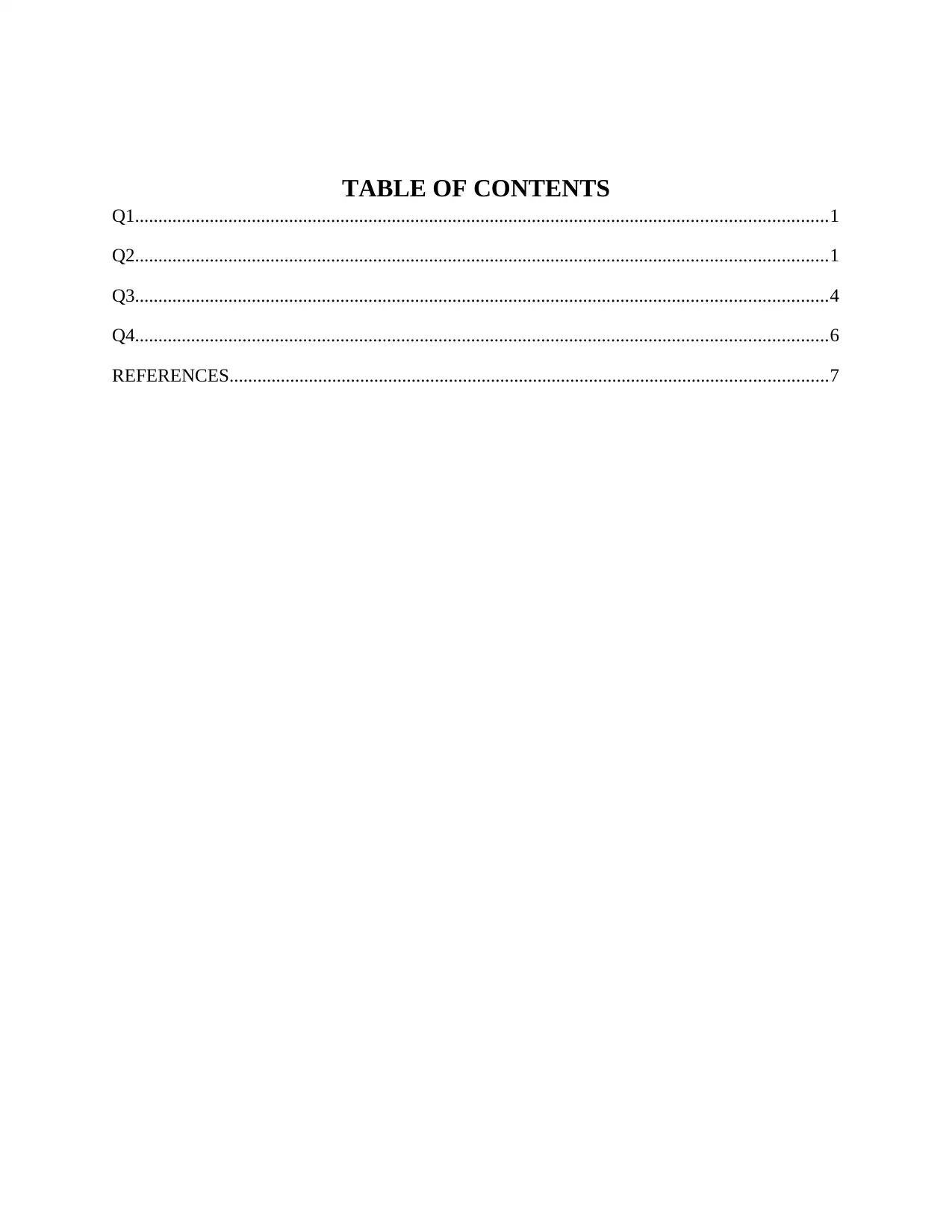
TABLE OF CONTENTS
Q1....................................................................................................................................................1
Q2....................................................................................................................................................1
Q3....................................................................................................................................................4
Q4....................................................................................................................................................6
REFERENCES................................................................................................................................7
Q1....................................................................................................................................................1
Q2....................................................................................................................................................1
Q3....................................................................................................................................................4
Q4....................................................................................................................................................6
REFERENCES................................................................................................................................7
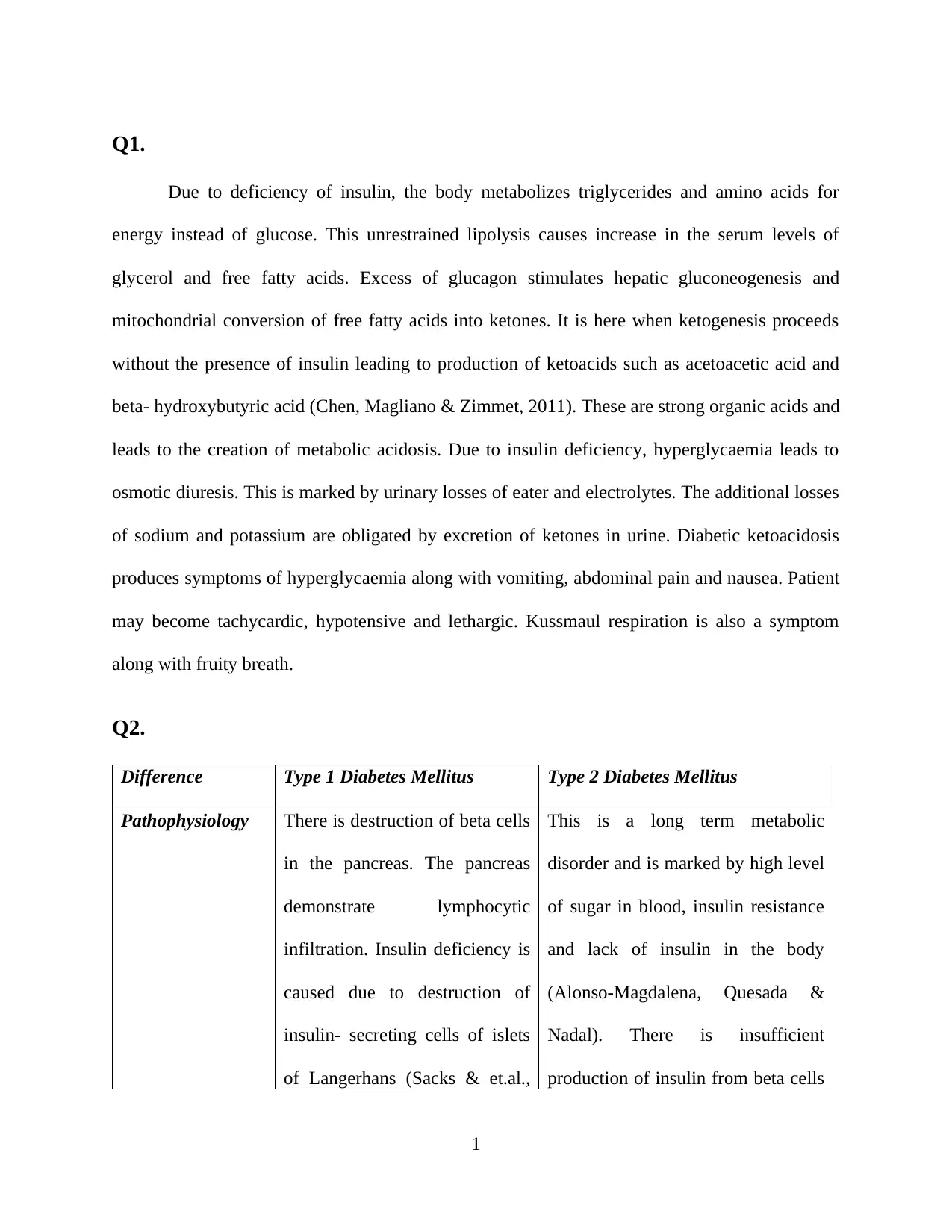
Q1.
Due to deficiency of insulin, the body metabolizes triglycerides and amino acids for
energy instead of glucose. This unrestrained lipolysis causes increase in the serum levels of
glycerol and free fatty acids. Excess of glucagon stimulates hepatic gluconeogenesis and
mitochondrial conversion of free fatty acids into ketones. It is here when ketogenesis proceeds
without the presence of insulin leading to production of ketoacids such as acetoacetic acid and
beta- hydroxybutyric acid (Chen, Magliano & Zimmet, 2011). These are strong organic acids and
leads to the creation of metabolic acidosis. Due to insulin deficiency, hyperglycaemia leads to
osmotic diuresis. This is marked by urinary losses of eater and electrolytes. The additional losses
of sodium and potassium are obligated by excretion of ketones in urine. Diabetic ketoacidosis
produces symptoms of hyperglycaemia along with vomiting, abdominal pain and nausea. Patient
may become tachycardic, hypotensive and lethargic. Kussmaul respiration is also a symptom
along with fruity breath.
Q2.
Difference Type 1 Diabetes Mellitus Type 2 Diabetes Mellitus
Pathophysiology There is destruction of beta cells
in the pancreas. The pancreas
demonstrate lymphocytic
infiltration. Insulin deficiency is
caused due to destruction of
insulin- secreting cells of islets
of Langerhans (Sacks & et.al.,
This is a long term metabolic
disorder and is marked by high level
of sugar in blood, insulin resistance
and lack of insulin in the body
(Alonso-Magdalena, Quesada &
Nadal). There is insufficient
production of insulin from beta cells
1
Due to deficiency of insulin, the body metabolizes triglycerides and amino acids for
energy instead of glucose. This unrestrained lipolysis causes increase in the serum levels of
glycerol and free fatty acids. Excess of glucagon stimulates hepatic gluconeogenesis and
mitochondrial conversion of free fatty acids into ketones. It is here when ketogenesis proceeds
without the presence of insulin leading to production of ketoacids such as acetoacetic acid and
beta- hydroxybutyric acid (Chen, Magliano & Zimmet, 2011). These are strong organic acids and
leads to the creation of metabolic acidosis. Due to insulin deficiency, hyperglycaemia leads to
osmotic diuresis. This is marked by urinary losses of eater and electrolytes. The additional losses
of sodium and potassium are obligated by excretion of ketones in urine. Diabetic ketoacidosis
produces symptoms of hyperglycaemia along with vomiting, abdominal pain and nausea. Patient
may become tachycardic, hypotensive and lethargic. Kussmaul respiration is also a symptom
along with fruity breath.
Q2.
Difference Type 1 Diabetes Mellitus Type 2 Diabetes Mellitus
Pathophysiology There is destruction of beta cells
in the pancreas. The pancreas
demonstrate lymphocytic
infiltration. Insulin deficiency is
caused due to destruction of
insulin- secreting cells of islets
of Langerhans (Sacks & et.al.,
This is a long term metabolic
disorder and is marked by high level
of sugar in blood, insulin resistance
and lack of insulin in the body
(Alonso-Magdalena, Quesada &
Nadal). There is insufficient
production of insulin from beta cells
1
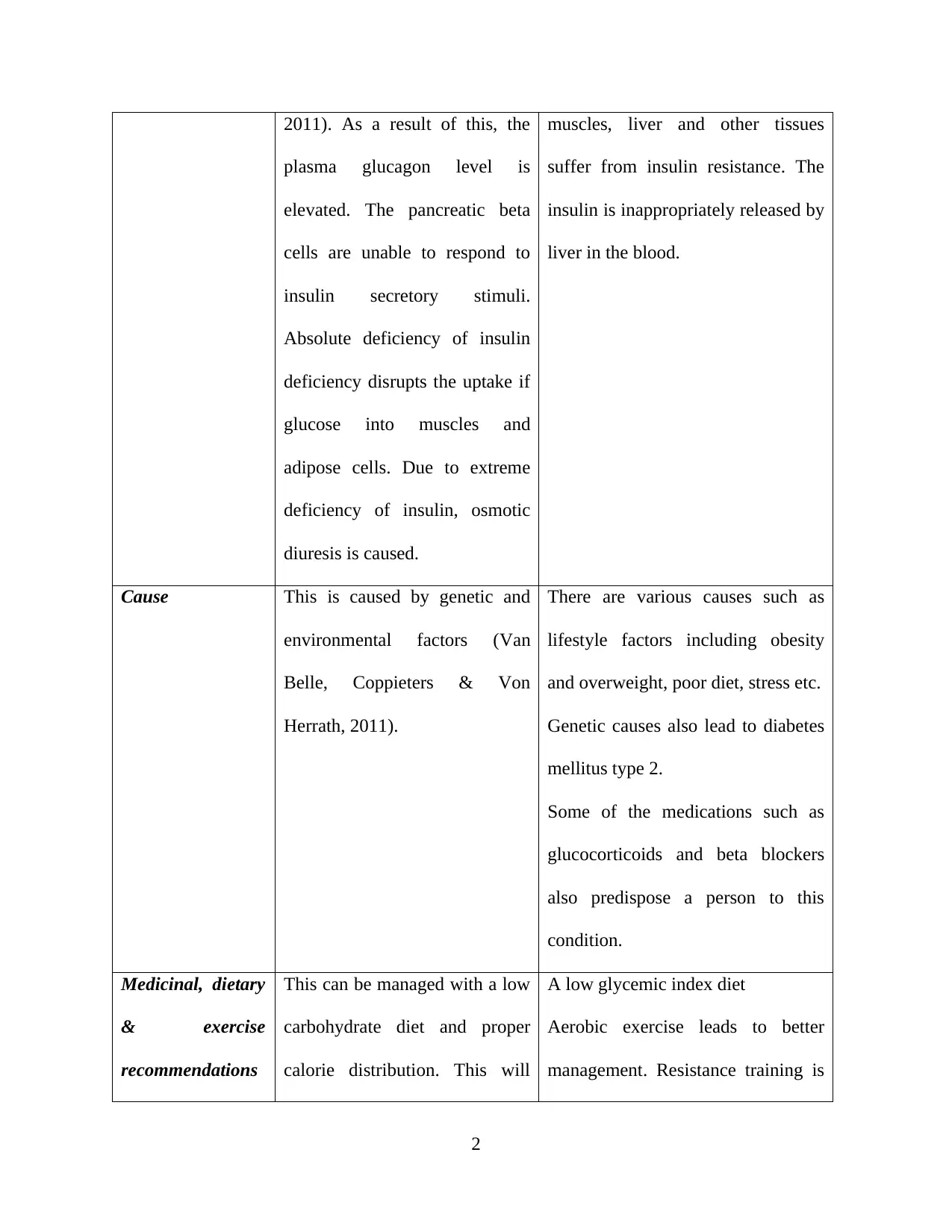
2011). As a result of this, the
plasma glucagon level is
elevated. The pancreatic beta
cells are unable to respond to
insulin secretory stimuli.
Absolute deficiency of insulin
deficiency disrupts the uptake if
glucose into muscles and
adipose cells. Due to extreme
deficiency of insulin, osmotic
diuresis is caused.
muscles, liver and other tissues
suffer from insulin resistance. The
insulin is inappropriately released by
liver in the blood.
Cause This is caused by genetic and
environmental factors (Van
Belle, Coppieters & Von
Herrath, 2011).
There are various causes such as
lifestyle factors including obesity
and overweight, poor diet, stress etc.
Genetic causes also lead to diabetes
mellitus type 2.
Some of the medications such as
glucocorticoids and beta blockers
also predispose a person to this
condition.
Medicinal, dietary
& exercise
recommendations
This can be managed with a low
carbohydrate diet and proper
calorie distribution. This will
A low glycemic index diet
Aerobic exercise leads to better
management. Resistance training is
2
plasma glucagon level is
elevated. The pancreatic beta
cells are unable to respond to
insulin secretory stimuli.
Absolute deficiency of insulin
deficiency disrupts the uptake if
glucose into muscles and
adipose cells. Due to extreme
deficiency of insulin, osmotic
diuresis is caused.
muscles, liver and other tissues
suffer from insulin resistance. The
insulin is inappropriately released by
liver in the blood.
Cause This is caused by genetic and
environmental factors (Van
Belle, Coppieters & Von
Herrath, 2011).
There are various causes such as
lifestyle factors including obesity
and overweight, poor diet, stress etc.
Genetic causes also lead to diabetes
mellitus type 2.
Some of the medications such as
glucocorticoids and beta blockers
also predispose a person to this
condition.
Medicinal, dietary
& exercise
recommendations
This can be managed with a low
carbohydrate diet and proper
calorie distribution. This will
A low glycemic index diet
Aerobic exercise leads to better
management. Resistance training is
2
Secure Best Marks with AI Grader
Need help grading? Try our AI Grader for instant feedback on your assignments.
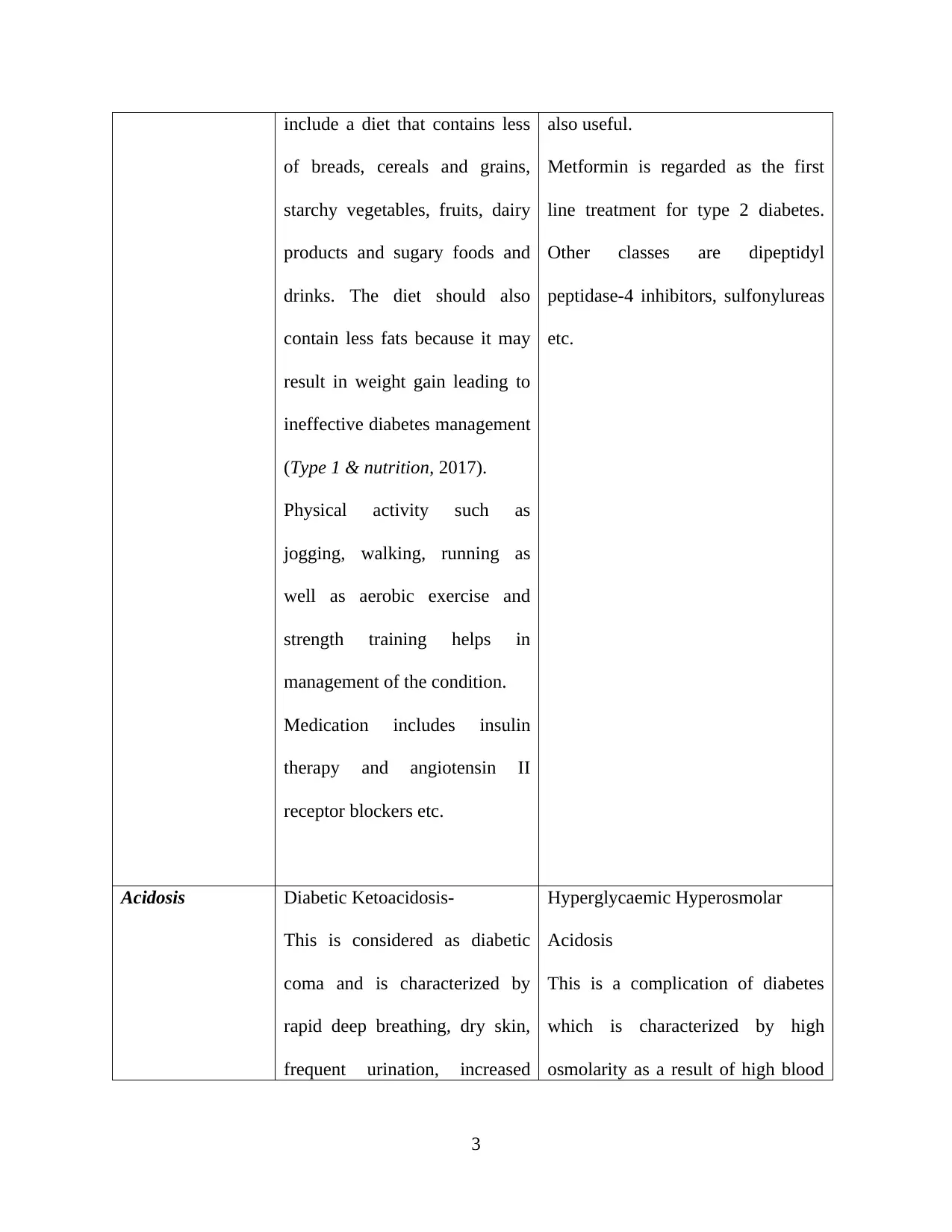
include a diet that contains less
of breads, cereals and grains,
starchy vegetables, fruits, dairy
products and sugary foods and
drinks. The diet should also
contain less fats because it may
result in weight gain leading to
ineffective diabetes management
(Type 1 & nutrition, 2017).
Physical activity such as
jogging, walking, running as
well as aerobic exercise and
strength training helps in
management of the condition.
Medication includes insulin
therapy and angiotensin II
receptor blockers etc.
also useful.
Metformin is regarded as the first
line treatment for type 2 diabetes.
Other classes are dipeptidyl
peptidase-4 inhibitors, sulfonylureas
etc.
Acidosis Diabetic Ketoacidosis-
This is considered as diabetic
coma and is characterized by
rapid deep breathing, dry skin,
frequent urination, increased
Hyperglycaemic Hyperosmolar
Acidosis
This is a complication of diabetes
which is characterized by high
osmolarity as a result of high blood
3
of breads, cereals and grains,
starchy vegetables, fruits, dairy
products and sugary foods and
drinks. The diet should also
contain less fats because it may
result in weight gain leading to
ineffective diabetes management
(Type 1 & nutrition, 2017).
Physical activity such as
jogging, walking, running as
well as aerobic exercise and
strength training helps in
management of the condition.
Medication includes insulin
therapy and angiotensin II
receptor blockers etc.
also useful.
Metformin is regarded as the first
line treatment for type 2 diabetes.
Other classes are dipeptidyl
peptidase-4 inhibitors, sulfonylureas
etc.
Acidosis Diabetic Ketoacidosis-
This is considered as diabetic
coma and is characterized by
rapid deep breathing, dry skin,
frequent urination, increased
Hyperglycaemic Hyperosmolar
Acidosis
This is a complication of diabetes
which is characterized by high
osmolarity as a result of high blood
3
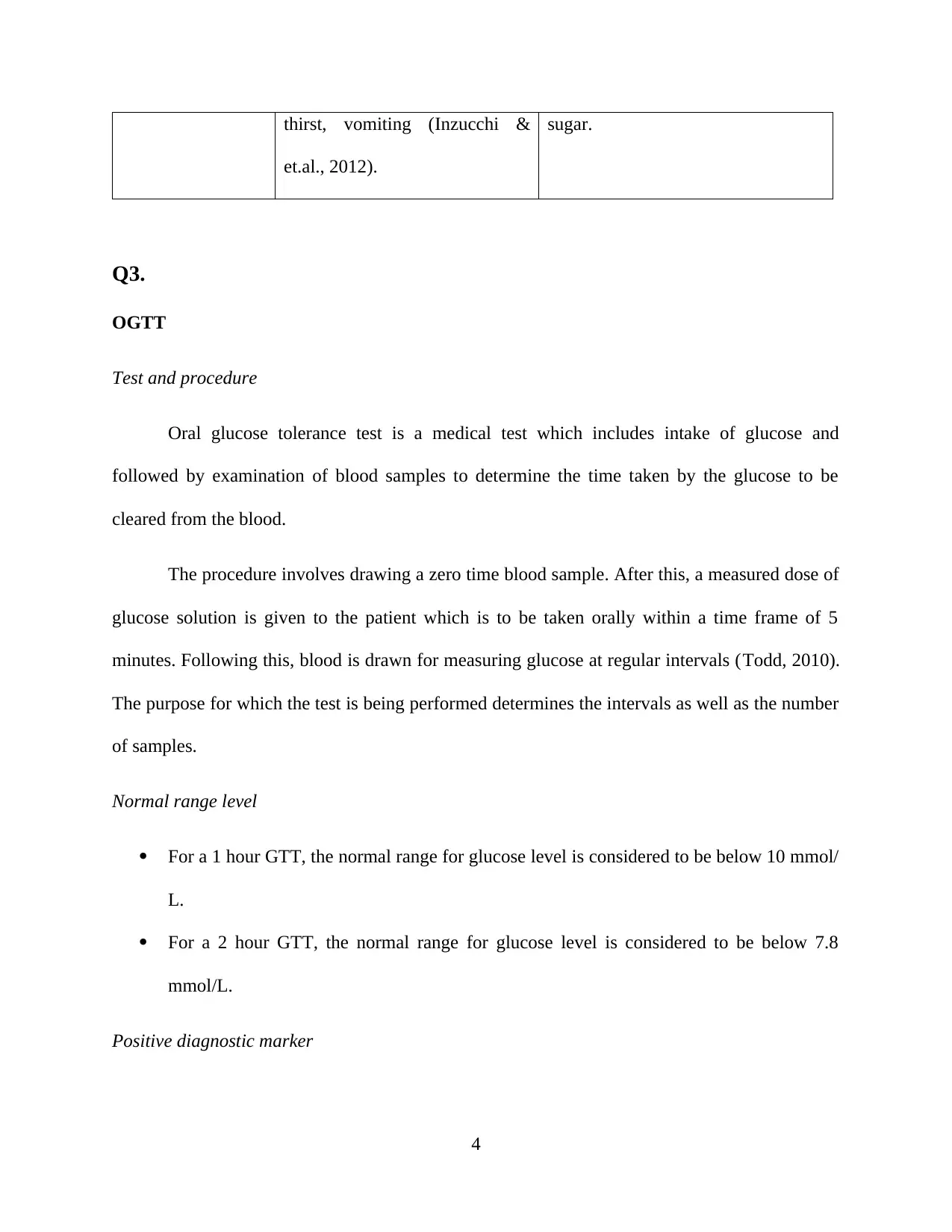
thirst, vomiting (Inzucchi &
et.al., 2012).
sugar.
Q3.
OGTT
Test and procedure
Oral glucose tolerance test is a medical test which includes intake of glucose and
followed by examination of blood samples to determine the time taken by the glucose to be
cleared from the blood.
The procedure involves drawing a zero time blood sample. After this, a measured dose of
glucose solution is given to the patient which is to be taken orally within a time frame of 5
minutes. Following this, blood is drawn for measuring glucose at regular intervals (Todd, 2010).
The purpose for which the test is being performed determines the intervals as well as the number
of samples.
Normal range level
For a 1 hour GTT, the normal range for glucose level is considered to be below 10 mmol/
L.
For a 2 hour GTT, the normal range for glucose level is considered to be below 7.8
mmol/L.
Positive diagnostic marker
4
et.al., 2012).
sugar.
Q3.
OGTT
Test and procedure
Oral glucose tolerance test is a medical test which includes intake of glucose and
followed by examination of blood samples to determine the time taken by the glucose to be
cleared from the blood.
The procedure involves drawing a zero time blood sample. After this, a measured dose of
glucose solution is given to the patient which is to be taken orally within a time frame of 5
minutes. Following this, blood is drawn for measuring glucose at regular intervals (Todd, 2010).
The purpose for which the test is being performed determines the intervals as well as the number
of samples.
Normal range level
For a 1 hour GTT, the normal range for glucose level is considered to be below 10 mmol/
L.
For a 2 hour GTT, the normal range for glucose level is considered to be below 7.8
mmol/L.
Positive diagnostic marker
4
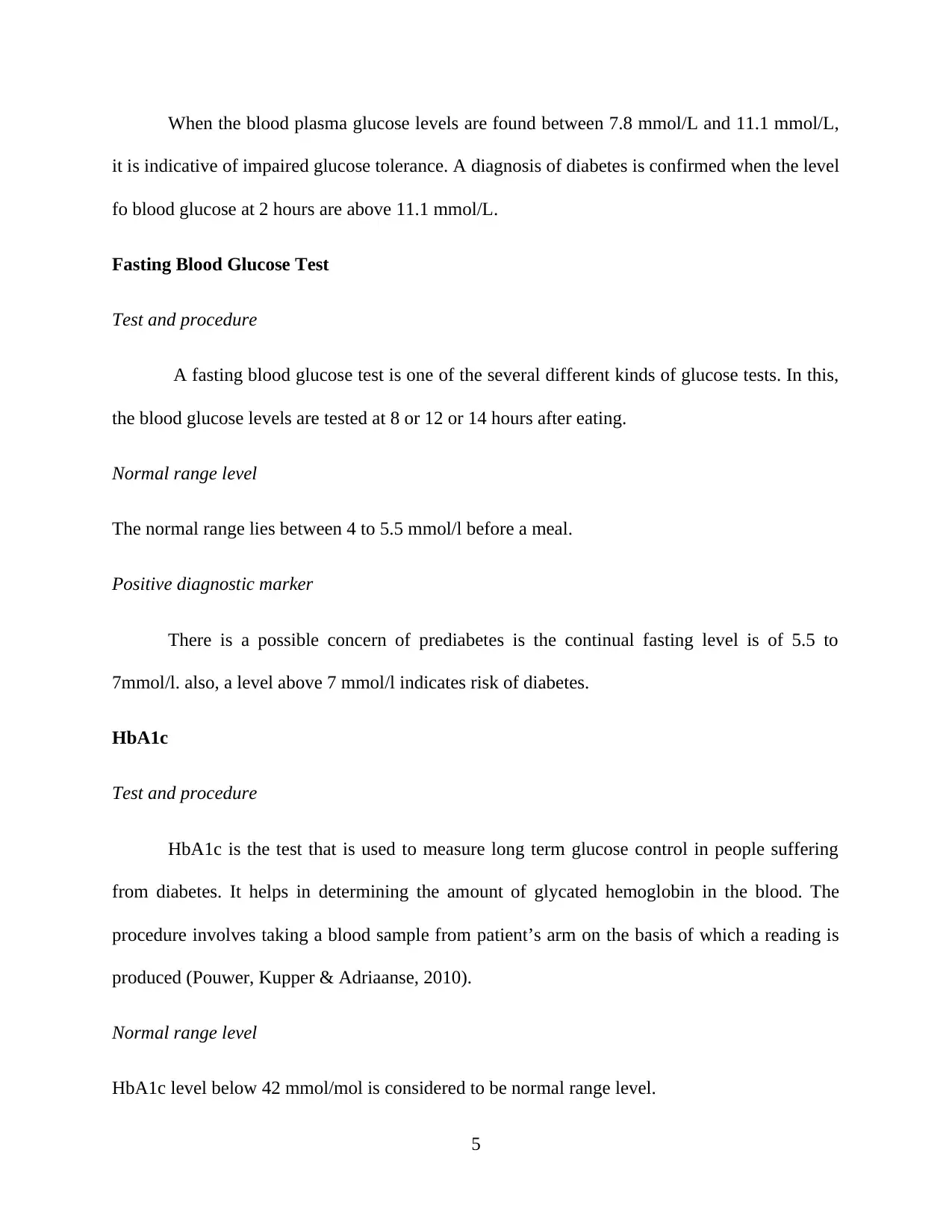
When the blood plasma glucose levels are found between 7.8 mmol/L and 11.1 mmol/L,
it is indicative of impaired glucose tolerance. A diagnosis of diabetes is confirmed when the level
fo blood glucose at 2 hours are above 11.1 mmol/L.
Fasting Blood Glucose Test
Test and procedure
A fasting blood glucose test is one of the several different kinds of glucose tests. In this,
the blood glucose levels are tested at 8 or 12 or 14 hours after eating.
Normal range level
The normal range lies between 4 to 5.5 mmol/l before a meal.
Positive diagnostic marker
There is a possible concern of prediabetes is the continual fasting level is of 5.5 to
7mmol/l. also, a level above 7 mmol/l indicates risk of diabetes.
HbA1c
Test and procedure
HbA1c is the test that is used to measure long term glucose control in people suffering
from diabetes. It helps in determining the amount of glycated hemoglobin in the blood. The
procedure involves taking a blood sample from patient’s arm on the basis of which a reading is
produced (Pouwer, Kupper & Adriaanse, 2010).
Normal range level
HbA1c level below 42 mmol/mol is considered to be normal range level.
5
it is indicative of impaired glucose tolerance. A diagnosis of diabetes is confirmed when the level
fo blood glucose at 2 hours are above 11.1 mmol/L.
Fasting Blood Glucose Test
Test and procedure
A fasting blood glucose test is one of the several different kinds of glucose tests. In this,
the blood glucose levels are tested at 8 or 12 or 14 hours after eating.
Normal range level
The normal range lies between 4 to 5.5 mmol/l before a meal.
Positive diagnostic marker
There is a possible concern of prediabetes is the continual fasting level is of 5.5 to
7mmol/l. also, a level above 7 mmol/l indicates risk of diabetes.
HbA1c
Test and procedure
HbA1c is the test that is used to measure long term glucose control in people suffering
from diabetes. It helps in determining the amount of glycated hemoglobin in the blood. The
procedure involves taking a blood sample from patient’s arm on the basis of which a reading is
produced (Pouwer, Kupper & Adriaanse, 2010).
Normal range level
HbA1c level below 42 mmol/mol is considered to be normal range level.
5
Paraphrase This Document
Need a fresh take? Get an instant paraphrase of this document with our AI Paraphraser
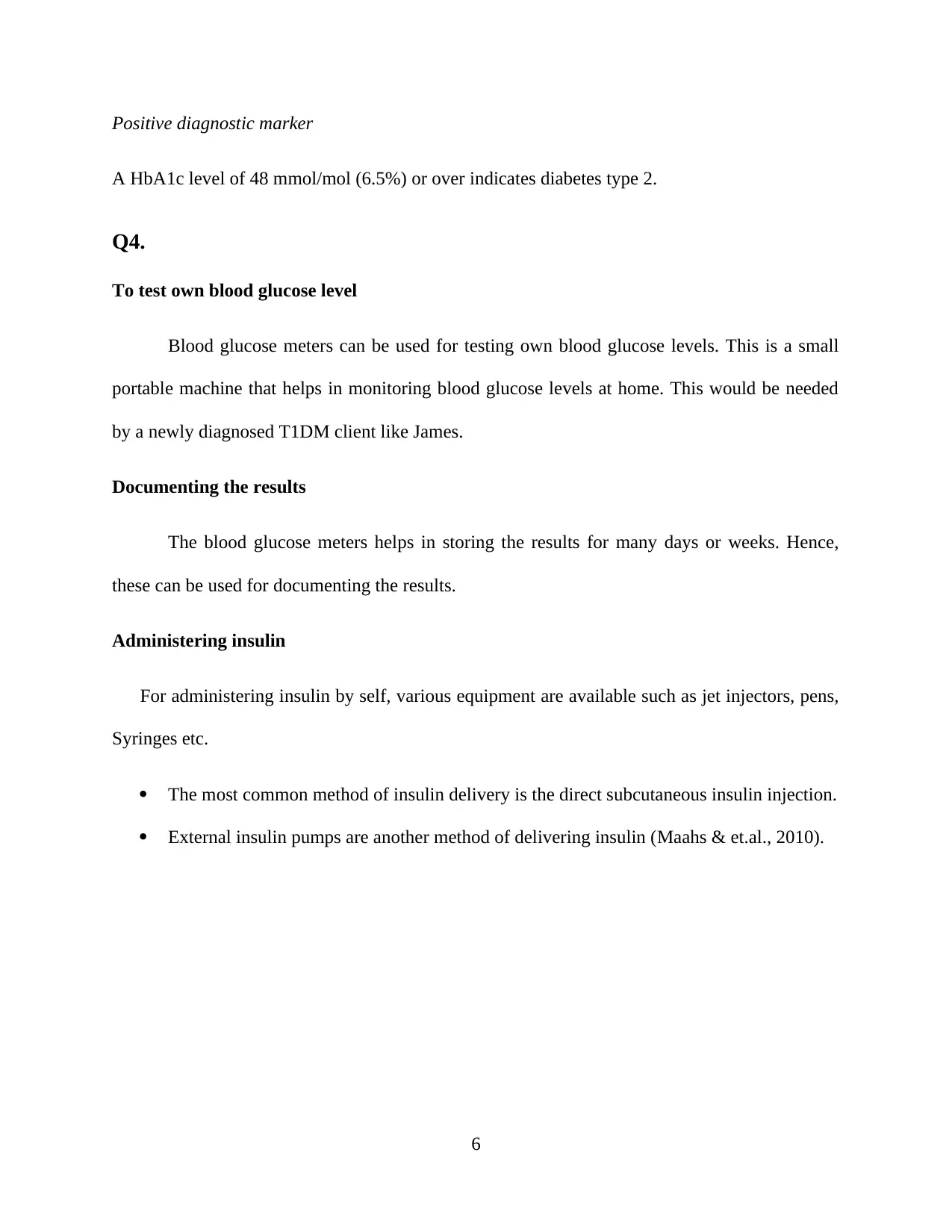
Positive diagnostic marker
A HbA1c level of 48 mmol/mol (6.5%) or over indicates diabetes type 2.
Q4.
To test own blood glucose level
Blood glucose meters can be used for testing own blood glucose levels. This is a small
portable machine that helps in monitoring blood glucose levels at home. This would be needed
by a newly diagnosed T1DM client like James.
Documenting the results
The blood glucose meters helps in storing the results for many days or weeks. Hence,
these can be used for documenting the results.
Administering insulin
For administering insulin by self, various equipment are available such as jet injectors, pens,
Syringes etc.
The most common method of insulin delivery is the direct subcutaneous insulin injection.
External insulin pumps are another method of delivering insulin (Maahs & et.al., 2010).
6
A HbA1c level of 48 mmol/mol (6.5%) or over indicates diabetes type 2.
Q4.
To test own blood glucose level
Blood glucose meters can be used for testing own blood glucose levels. This is a small
portable machine that helps in monitoring blood glucose levels at home. This would be needed
by a newly diagnosed T1DM client like James.
Documenting the results
The blood glucose meters helps in storing the results for many days or weeks. Hence,
these can be used for documenting the results.
Administering insulin
For administering insulin by self, various equipment are available such as jet injectors, pens,
Syringes etc.
The most common method of insulin delivery is the direct subcutaneous insulin injection.
External insulin pumps are another method of delivering insulin (Maahs & et.al., 2010).
6
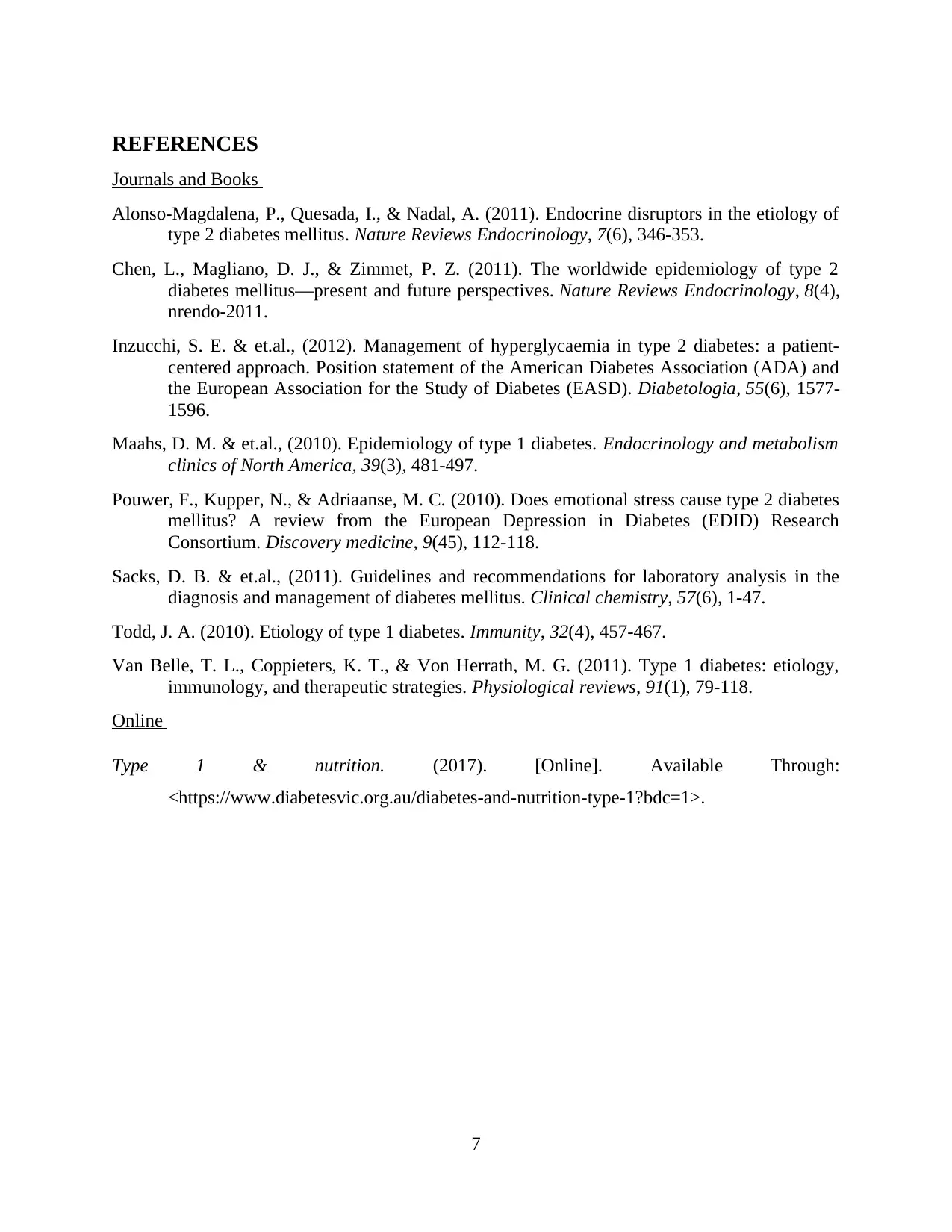
REFERENCES
Journals and Books
Alonso-Magdalena, P., Quesada, I., & Nadal, A. (2011). Endocrine disruptors in the etiology of
type 2 diabetes mellitus. Nature Reviews Endocrinology, 7(6), 346-353.
Chen, L., Magliano, D. J., & Zimmet, P. Z. (2011). The worldwide epidemiology of type 2
diabetes mellitus—present and future perspectives. Nature Reviews Endocrinology, 8(4),
nrendo-2011.
Inzucchi, S. E. & et.al., (2012). Management of hyperglycaemia in type 2 diabetes: a patient-
centered approach. Position statement of the American Diabetes Association (ADA) and
the European Association for the Study of Diabetes (EASD). Diabetologia, 55(6), 1577-
1596.
Maahs, D. M. & et.al., (2010). Epidemiology of type 1 diabetes. Endocrinology and metabolism
clinics of North America, 39(3), 481-497.
Pouwer, F., Kupper, N., & Adriaanse, M. C. (2010). Does emotional stress cause type 2 diabetes
mellitus? A review from the European Depression in Diabetes (EDID) Research
Consortium. Discovery medicine, 9(45), 112-118.
Sacks, D. B. & et.al., (2011). Guidelines and recommendations for laboratory analysis in the
diagnosis and management of diabetes mellitus. Clinical chemistry, 57(6), 1-47.
Todd, J. A. (2010). Etiology of type 1 diabetes. Immunity, 32(4), 457-467.
Van Belle, T. L., Coppieters, K. T., & Von Herrath, M. G. (2011). Type 1 diabetes: etiology,
immunology, and therapeutic strategies. Physiological reviews, 91(1), 79-118.
Online
Type 1 & nutrition. (2017). [Online]. Available Through:
<https://www.diabetesvic.org.au/diabetes-and-nutrition-type-1?bdc=1>.
7
Journals and Books
Alonso-Magdalena, P., Quesada, I., & Nadal, A. (2011). Endocrine disruptors in the etiology of
type 2 diabetes mellitus. Nature Reviews Endocrinology, 7(6), 346-353.
Chen, L., Magliano, D. J., & Zimmet, P. Z. (2011). The worldwide epidemiology of type 2
diabetes mellitus—present and future perspectives. Nature Reviews Endocrinology, 8(4),
nrendo-2011.
Inzucchi, S. E. & et.al., (2012). Management of hyperglycaemia in type 2 diabetes: a patient-
centered approach. Position statement of the American Diabetes Association (ADA) and
the European Association for the Study of Diabetes (EASD). Diabetologia, 55(6), 1577-
1596.
Maahs, D. M. & et.al., (2010). Epidemiology of type 1 diabetes. Endocrinology and metabolism
clinics of North America, 39(3), 481-497.
Pouwer, F., Kupper, N., & Adriaanse, M. C. (2010). Does emotional stress cause type 2 diabetes
mellitus? A review from the European Depression in Diabetes (EDID) Research
Consortium. Discovery medicine, 9(45), 112-118.
Sacks, D. B. & et.al., (2011). Guidelines and recommendations for laboratory analysis in the
diagnosis and management of diabetes mellitus. Clinical chemistry, 57(6), 1-47.
Todd, J. A. (2010). Etiology of type 1 diabetes. Immunity, 32(4), 457-467.
Van Belle, T. L., Coppieters, K. T., & Von Herrath, M. G. (2011). Type 1 diabetes: etiology,
immunology, and therapeutic strategies. Physiological reviews, 91(1), 79-118.
Online
Type 1 & nutrition. (2017). [Online]. Available Through:
<https://www.diabetesvic.org.au/diabetes-and-nutrition-type-1?bdc=1>.
7
1 out of 9
Related Documents
Your All-in-One AI-Powered Toolkit for Academic Success.
+13062052269
info@desklib.com
Available 24*7 on WhatsApp / Email
![[object Object]](/_next/static/media/star-bottom.7253800d.svg)
Unlock your academic potential
© 2024 | Zucol Services PVT LTD | All rights reserved.





